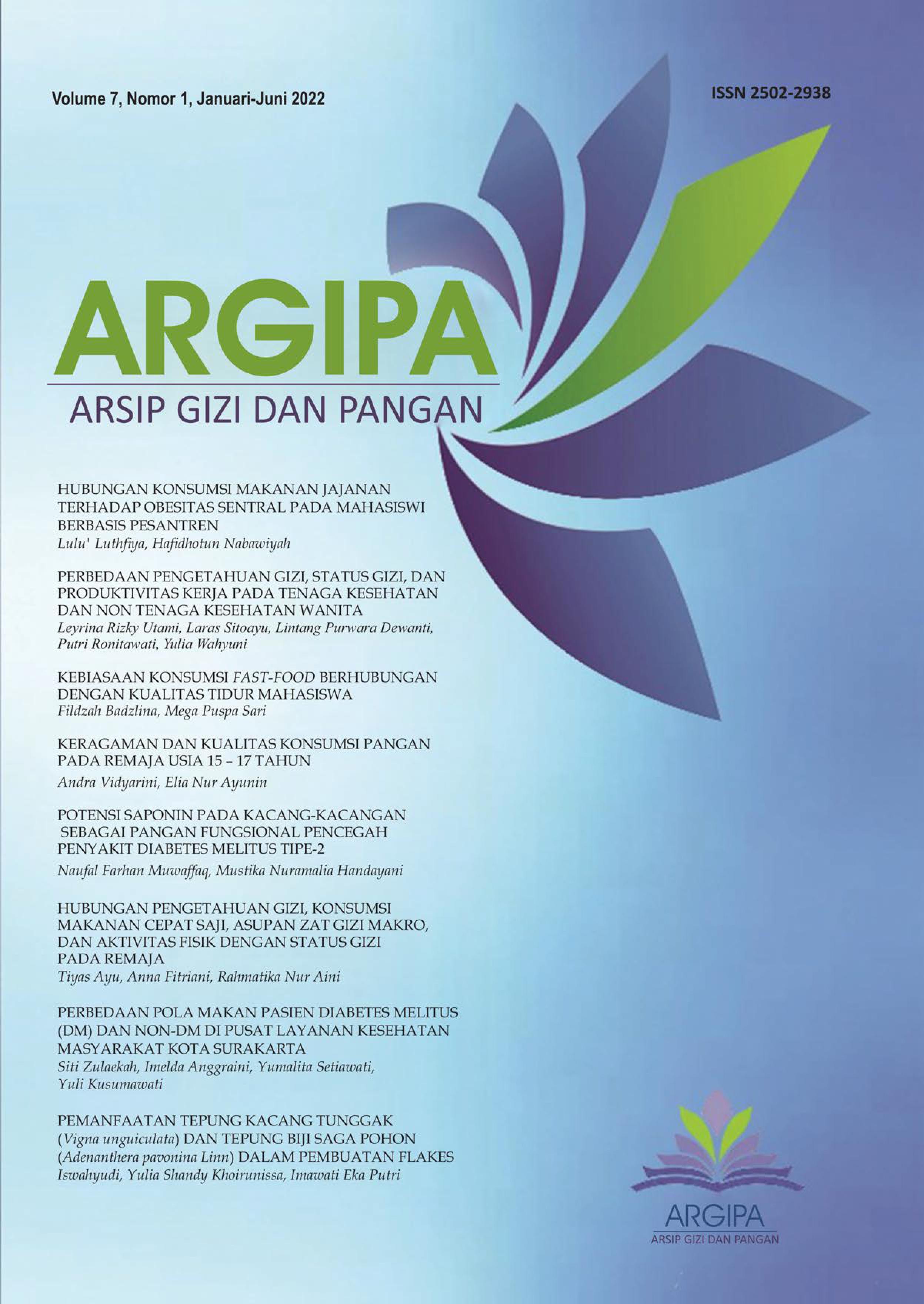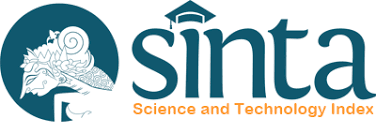Diversity and quality of food consumption in adolescents aged 15–17 years
DOI:
https://doi.org/10.22236/argipa.v7i1.7951Keywords:
Healthy Eating Index (HEI), Food Diversity, Quality of Consumption, AdolescentAbstract
Nutritional problems in adolescents have increased from year to year and one of the causes is the low diversity and quality of consumption. The diversity and quality of consumption can be seen through the Individual Dietary Diversity Score and the Healthy Eating Index. This study was cross-sectional by looking at the diversity and quality of consumption of adolescents aged 15-17 years. The total subjects in this study amounted to 70 teenagers. This research was conducted online via google form and the results were analyzed using chi-square. The results showed that the diversity of the subject's food consumption was in the diverse and very diverse category with an average of 6. However, the quality was still not good whereas it was still in the bad and moderate categories with an average of 12,93. Analysis of the relationship between diversity and quality of food consumption showed that consumption diversity had a significant relationship with the quality of food consumption. These results indicated that the more diverse the food consumed, the better the quality of food consumption.Downloads
References
Bitra. (2010). Keanekaragaman pangan untuk antisipasi kekurangan pangan. Diunduh dari: http://bitra.or.id/2012/2010/10/15/keanekaragaman-pangan-untukantisipasi-kekurangan-pangan/
Brown, J. E. (2011). Nutrition through the Life Cycle. Wadsworth (US): Cengage Learning.
Danty, F. R., Syah, M. N., & Sari, A. E. (2019). Hubungan indeks gizi seimbang dengan status gizi pada remaja putri di SMK Kota Bekasi. Jurnal Kesehatan Indonesia, 10(1), 43-54.
Efrizal, W. (2020). Persepsi dan pola konsumsi remaja selama pandemi covid-19. Jurnal Penelitian Biologi, Botani, Zoologi, dan Mikrobiologi, 5(2), 43-48.
Erwin, P. P. & Karmini, N. L. (2012). Pengaruh pendapatan, jumlah anggota keluarga, dan pendidikan terhadap pola konsumsi rumah tangga miskin di Kecamatan Gianyar. E-Jurnal Ekonomi Pembangunan. 1(1), 39–48.
Fikawati, S., Syafiq, A., & Vertamala, A. (2017). Gizi Anak dan Remaja. Jakarta: PT Rajagrafindo Persada.
Gibson, R. (2005). Principles of Nutritional Assessment. Oxford University. New York.
Hardinsyah. (2007). Review faktor determinan keragaman konsumsi pangan. Jurnal Gizi dan Pangan, 2(2), 55–74.
Kementerian Kesehatan RI. (2013). Laporan Nasional Riskesdas. Badan Penelitian dan Pengembangan Kesehatan.
Kementerian Kesehatan RI. (2014). Peraturan Menteri Kesehatan RI Nomor 25 Tahun 2014. Jakarta: Kemenkes RI
Kementerian Kesehatan RI. (2018). Laporan Nasional Riskesdas. Badan Penelitian dan Pengembangan Kesehatan.
Kennedy, E. (2008). Putting the pyramid into action: the healthy eating index and food quality score. Asia Pac J Clin Nutr. 17(1), 70-74.
Kennedy, G., Ballard, T. & MarieClaude. (2011). Guidelines for measuring household and individual dietary diversity. FAO: Rome-Italy.
Kristiandi K. 2015. Analisis kualitas konsumsi pangan rumah tangga dan status gizi balita pada masyarakat Kasepuhan Ciptagelar Sukabumi [tesis]. Bogor:IPB
Lee J, Hauser RF, Must A, de Fulladolsa PP, Bermudez OI. 2012. Socioeconomic disparities and the familial coexistence of child stunting and maternal overweigth in Guatemala. Economic and Human Biology Elsevier BV. 10:232-41. doi: 10.1016/j.ehb.2011.08.002.
Lietz, G., Barton, K. L., Longbottom, P. J., Anderson, A. S. (2002). Can the EPIC food frequency questionnaire be used in adolescent populations? Public Health Nutrition, 5(6), 783-789.
Meisya, Y. D. (2014). Skor keaneka-ragaman konsumsi pangan (dietary diversity score) remaja di Bandung dan Padang. Skripsi. Bogor: IPB.
Mirmiran, P., Azadbakht, L., Esmaillzadeh, A., & Azizi, F. (2004). Dietary diversity score in adolescents-a good indicator of the nutritional adequacy of diets: Tehran lipid and glucose study. Asia Pacific Journal of Clinical Nutrition, 13(1), 56–60.
Oldewage-Theron, W. & Kruger, R. (2011). Dietary diversity and adequacy of women caregivers in a peri-urban informal settlement in South Africa. EPub. 27(4), 420–427. DOI: 10.1016/j.nut.2010.05.013.
Papalia, D. E., Olds, S. W., & Feldman, R. O. (2007). Human Development. USA: MCGraw-Hill.
Rahmawati, Hardinsyah, & Roosita, K. (2015). Pengembangan indeks gizi seimbang untuk menilai kualitas gizi konsumsi pangan remaja (13-15 Tahun) di Indonesia. Jurnal MKMI, 11(3), 160-167.
Ronitawati, P., Ghifari, N., Nuzrina, R., & Nurhasanah, Y. P. (2021). Analisis faktor-faktor yang berhubungan dengan kualitas konsumsi pangan dan status gizi pada remaja di perkotaan. Jurnal Sains Kesehatan. 28(1), 1–11.
Ruel MT. (2003). Is dietary diversity an indicator of food security or dietary quality? A review of measurement issues and research needs. Food and Nutrition Bulletin. 24(2), 231–232.
Savige, G. S, Ball, K., Worsley, A., & Crawford, D. (2007). Food intake patterns among Australian adolescents. Asia Pacific Journal Clinical Nutrition, 16(4), 738-47.
Soebroto, R. J. (2018). Hubungan Body Image Dissatisfaction, Status Gizi, dan Kualitas Konsumsi Pangan Remaja di Sekolah Krista Mitra, Semarang. Skripsi. Semarang: Universitas Katolik Soegijapranata.
[WHO] World Health Organization. (2018). Adolescent health in the South-East Asia Region [internet] https://www.who.int/southeastasia/health-topics/adolescent-health#:~:text=WHO%20defines%20'Adolescents'%20as%20individuals,age%20range%2010%2D24%20years (diakses tanggal 22 Februari 2021).
Wantina, M., Rahayu, L. S., & Yuliana, I. (2017). Keragaman konsumsi pangan sebagai faktor risiko stunting pada balita usia 6-24 bulan. ARGIPA (Arsip Gizi dan Pangan), 2(2), 89-96.

















